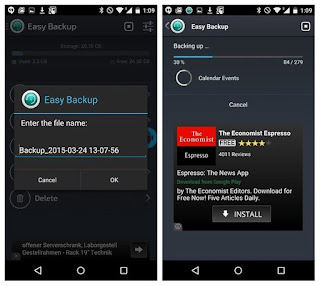MobiKin Assistant for Android
Backups are indispensable. Whether it's a backup of your Android smartphone, your photo albums or your laptop PC, backups come in at just the right moment to save the day. There is nothing worse than losing everything on your phone or computer and realizing you never backed anything up. So here are a few methods for making an Android backup.
MobiKin Assistant for Android
Follow the few steps after downloading and your data will be safely backed up and your phone will have more free memory.
Google backup
As you probably know, Google is more than willing to help keep all your apps and data safe. If you go into your phone's settings, you'll find a section called Backup & Reset. In here you'll find an option for backing up your data, including Wi-Fi passwords, preferences and app data. All of this will be tied to your Google account, which you can set to automatically restore when you re-install an app.
App backup (for non-rooted phones)
There are plenty of useful backup solutions in the Play Store. Some for specific purposes like backing up your text messages and others for an all-in-one backup. Easy Easy Backup & Restore is a free app that lets you back up your contacts, call logs, text messages, calendars and bookmarks.
Easy Backup doesn't back up your photos, music, videos or documents. These are very easy to back up yourself though using a USB cable and your computer: just locate the appropriate folders on your phone in a Windows Explorer window and copy and paste the contents to your computer.
1. Download Easy Backup on your Android device.
2. When you launch the app, you'll be asked if you want to create a backup. Tap Yes.
3. You'll then see a bunch of check boxes next to the things you can back up: SMS, MMS, call logs, calendar, bookmarks, dictionary and contacts. Make your selections and tap OK.
4. You'll be asked for a save location for your backup. Make your selection and tap it.
5. If you select a cloud service you'll have to sign in. If you select SD card you'll have to confirm the directory.
6. You'll then be asked to give the backup a file name. The date and time is the default. If you have multiple devices you might want to modify the file name to include the device you're backing up.
7. You'll then see a progress page when your data is being backed up. Once completed, you'll get a pop up window with a summary of what was backed up
8. If your phone is rooted, you can also back up your apps and app data. If not, you can still tap on theApps Tools tab in the main menu and create a backup of the APKs on your phone. APKs are like an .exe on a computer: it's the program or app package. If your Google settings are enabled to back up your app data and settings (outlined above) you can use this option to back up the apps themselves and Google's backup to save the settings and data in the apps.
9. Just check the boxes next to the apps you want to save and hit Backup at the bottom
10. When you want to restore your apps or data, just hit the Restore tab. You'll be prompted to set Easy backup as the default SMS app. You can change this back once your backup has been restored
11. Select the backup you want to restore and tap it. You'll see a pop up with details of what will be restored. Tap OK and you're done.
12. Restoring your apps is slightly different. Go back to Apps Tools in the main menu and tap theArchived tab.
13. You can check off the APKs you want to restore, then tap Install at the bottom.
14. You'll then see the permissions screen for each app, like you would with any new app you install.
thank you




















